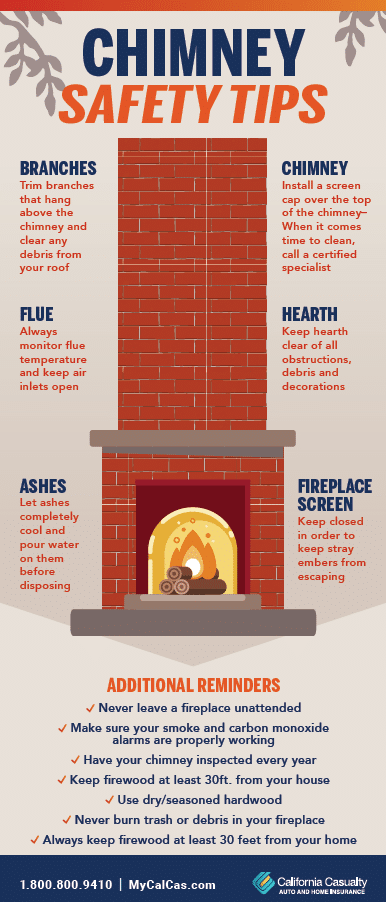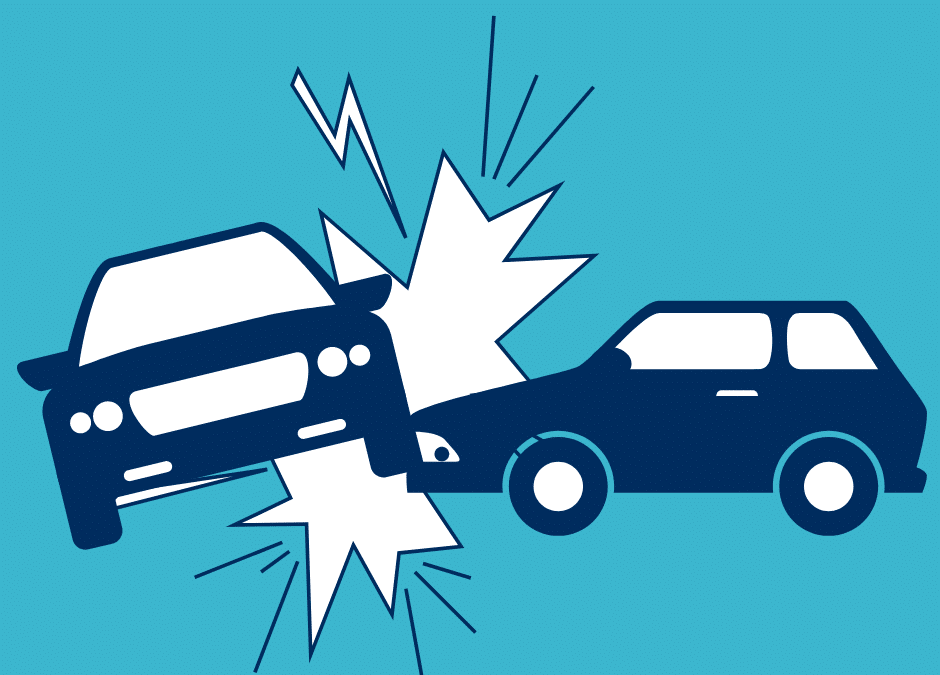
by California Casualty | Safety |
For a parent, they are few things more frightening than handing over the keys to their teenage children for the first time. Especially knowing that the risk of crashing is the highest between 16-19-year-olds than any other age group.
These teen driver safety tips can help ease your worry and make sure your teen is safe and ready to get behind the wheel.
- Enroll Them In Driver Education.
A dilemma for many parents is deciding whether to teach their child to drive or leave it up to an expert. The National Highway Traffic Safety Administration (NHTSA) recommends enrolling new drivers in a driver education program. This can help develop life-long safe driving habits. Each state has a list of approved driver education programs, often found on your state’s department of motor vehicles website. A resource for all states can be found at www.dmv.org/drivers-ed.php. teen driver safety
To ensure young drivers have the training and experience they need, safety groups are pushing for a national, mandatory graduated driver licensing system (GDL), which has proven to save lives.
- Research Which Vehicles Are Safer for Them.
When shopping for a vehicle for younger drivers, The National Highway Safety Institute recommends:
-
-
- Looking for bigger, heavier vehicles that offer more protection (no mini or small cars were on the list)
- Avoiding vehicles with high horsepower
- Considering vehicles with an electronic stability control system to maintain traction and control on curves and slippery roads
The Insurance Institute for Highway Safety does extensive crash tests on cars and trucks to rate them for safety. Since many parents opt for a used vehicle for new teen drivers, they created a list of those that meet important safety criteria. The prices range from $2,000 to nearly $20,000. They found 53 “Best Choices” under $20,000, and 62 “Good Choices” that start at under $10,000.
Some of the “Best Choice” vehicles $20,000 or less include:
-
-
- 2007 and newer Volvo S80 – large cars ($4,000)
- 2013 and newer (built after October 2012) Volkswagen Passat – midsized cars ($6,600)
- 2014 and newer (built after October 2013) Mazda CX-5 – small SUVs ($10,700)
These are some of the recommendations for “Good Choices” priced at $10,000 or less:
-
-
- 2010-2016 Buick LaCrosse – large cars ($6,200)
- 2009-2014 Volkswagen Jetta sedan and wagon – midsized cars ($3,800)
- 2007-2011 Honda Element – small SUVs ($4,400)
Most of these vehicles now include safety technology – such as collision avoidance systems and full airbag protection for drivers and passengers. See the complete list at https://www.iihs.org/ratings/safe-vehicles-for-teens.
- Observe Their Driving Habits.
Before you let your new driver start on the road to independence, check that he or she knows the vehicle and understands safe operating procedures, such as:
-
-
- Adjusting the seat and mirrors before leaving the driveway
- Putting on seat belts and ensuring that all passengers are buckled in
- Using turn signals
- Looking in all directions before pulling into traffic (even at green lights)
- Accelerating and braking smoothly
- Following at a safe distance
- Avoiding distractions
To help avoid confrontations with irate drivers, parents can put a “New Driver” sticker on the vehicle the new driver will be using.
- Reinforce the Dangers of Distracted Driving.
Distracted and inattentive driving is one of the leading causes of crashes for all drivers. Especially for teens. The crash rate for newly licensed teens was almost double that of teen drivers with a few years of experience, according to the NHTSA.
Here are some strategies to help prevent inattentive driving:
-
-
- Pledge, along with your teenage driver, to avoid texting or using social media behind the wheel.
- Use apps that block incoming calls and texts, and send alerts when the app is turned off.
- Teach children to speak out when they are with a driver who’s distracted.
- Request that they not speed, goof off, or drive impaired (or get into a car with someone who is upset or impaired).
- Help your teen map out routes and create music lists before heading out.
Impact Teen Drivers, a non-profit founded through a partnership between California Association of Highway Patrolmen, California Casualty and California Teachers Association, offers free, creative ways for parents and teens to educate young drivers about the dangers of distracted and careless driving. Visit www.impactteendrivers.org to learn more. teen driver safety
- Fully Insure Your Teen Drivers.
While higher auto insurance premiums are a hard reality for parents, you don’t want to skimp on your coverage. Did you know that California Casualty has really good rates for teen drivers?
Lack of experience behind the wheel makes them more likely to be involved in a collision, even a minor one. Increasing your liability limits, and adding full coverage, ensures that your insurance is enough to cover your assets. (Now is also a great time to learn more about an Umbrella Policy if you don’t already have one.)
Here are some ways to help manage the insurance costs for teen drivers:
-
-
- Take advantage of good student discounts
- Purchase cars that have modern safety features and a good safety rating
- Consider a monitoring system that tracks your young driver’s habits
- Enroll them in a defensive driving course
- Cut driving miles by carpooling and using mass transit
- Let your insurer know if the driver is away at college
Hopefully, your teen driver will gain experience, and you’ll feel more confident each time they get behind the wheel, knowing they are in the safest vehicle, armed with the best advice, and are paying attention to the road and other drivers.
This article is furnished by California Casualty, providing auto and home insurance to educators, law enforcement officers, firefighters and nurses. Get a quote at 1.866.704.8614 or www.calcas.com.
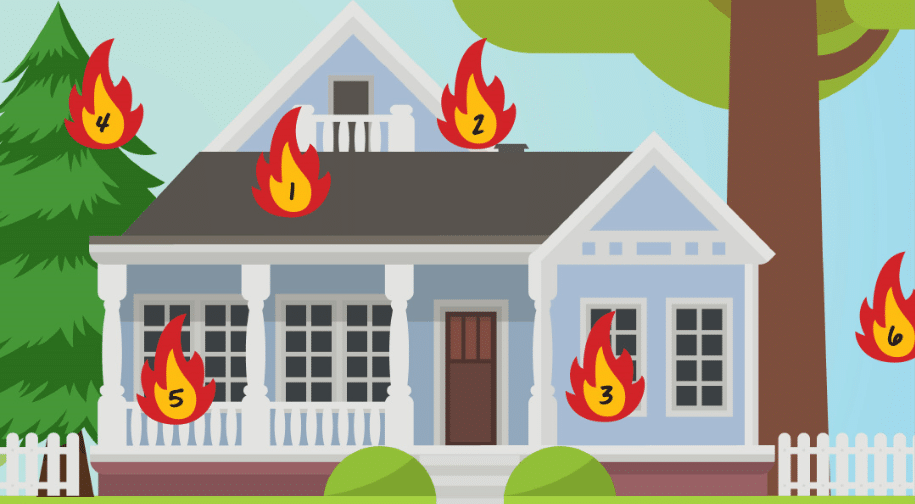
by California Casualty | Homeowners Insurance Info, Safety |
Wildland fires are becoming the new norm across much of the country, scorching more acreage with a ferocity that firefighters have not seen before. Now, more than ever, it’s important to understand fire behavior and the ways to prepare your home and community.
Don’t let your family’s possessions go up in smoke. The difference of a home in ashes and one still standing is often the result of simple actions taken to make the structure more survivable to heat, flame and embers. Removing bush, trimming trees, and creating 30-100 feet of defensible space is the best line of defense, but there is a lot more that homeowners and renters need to do.
As more people move into wildfire-prone areas, it’s imperative that we understand the areas around a house that are the greatest risk. Fire research has discovered blowing embers, not direct flames, cause most homes to ignite.
Here are the 6 most at-risk most vulnerable fire areas in and around your home.
- The Roof– This is the largest surface area on your home. Installing fire-resistant shingles can greatly reduce the risk. A Class A roof (asphalt shingles, metal, slate or tile) is considered the best protection. Repair any gaps in shingles and remove debris from plants or animals that an ember could nest in and ignite. Keep gutters free of flammable litter.
- Vents and Eaves– It’s imperative that homeowners keep flying embers from entering a home. Uncovered vents can allow hot ash and embers in. All vents should have a damper or screens to block embers from getting into the structure. If a fire is approaching, cover vents with duct tape, metal tape or plywood. Areas under eves are notorious for trapping burning ash and cinders. Clear them of nests and leaves, and make sure that the area is reinforced with fireproof materials.
- Windows– Extreme heat will warp window casings and shatter single-pane glass. Homes in fire-prone areas should have dual-pane tempered glass, with metal screens to block any flaming debris. Covering them with plywood if a fire is approaching also can help. If possible, installing roll-down metal shades over windows offers the best protection.
- Landscape– Create a five-foot fire resistant zone next to your home. Eliminate flammable plants such as junipers, dry grasses and scrub oak, replace wood mulch with rock or gravel, trim bushes and trees, and cut back overhanging branches that could allow flames to breach your dwelling. Trees should be dispersed and trimmed 10-feet from the ground
- Decks– These are another vulnerable area for embers and flames. Homeowners in fire-prone areas should consider lightweight concrete or metal decking. Fire-resistant treatments can help protect deck boards. Fire experts say most deck ignitions are created by flammable material on or under the deck (furniture, leaves, pine needles, woodpiles or mulch).
- Your Neighbor– All the work by homeowners to clear brush, remove woodpiles and trim trees up 10 feet from the ground can be for naught if nearby neighbors haven’t done the work. Property overgrown with weeds, brush and trees can endanger others, causing a wildfire to spread more rapidly and grow. Neighbors working together can greatly reduce the risk while increasing the survivability of their entire community. The National Fire Protection Association, in conjunction with other fire safety groups, has created the Firewise USA program, to organize homeowner associations, neighborhood groups and entire communities, and teach them how to work together to reduce the risk of wildfire.
Download the infographic here.
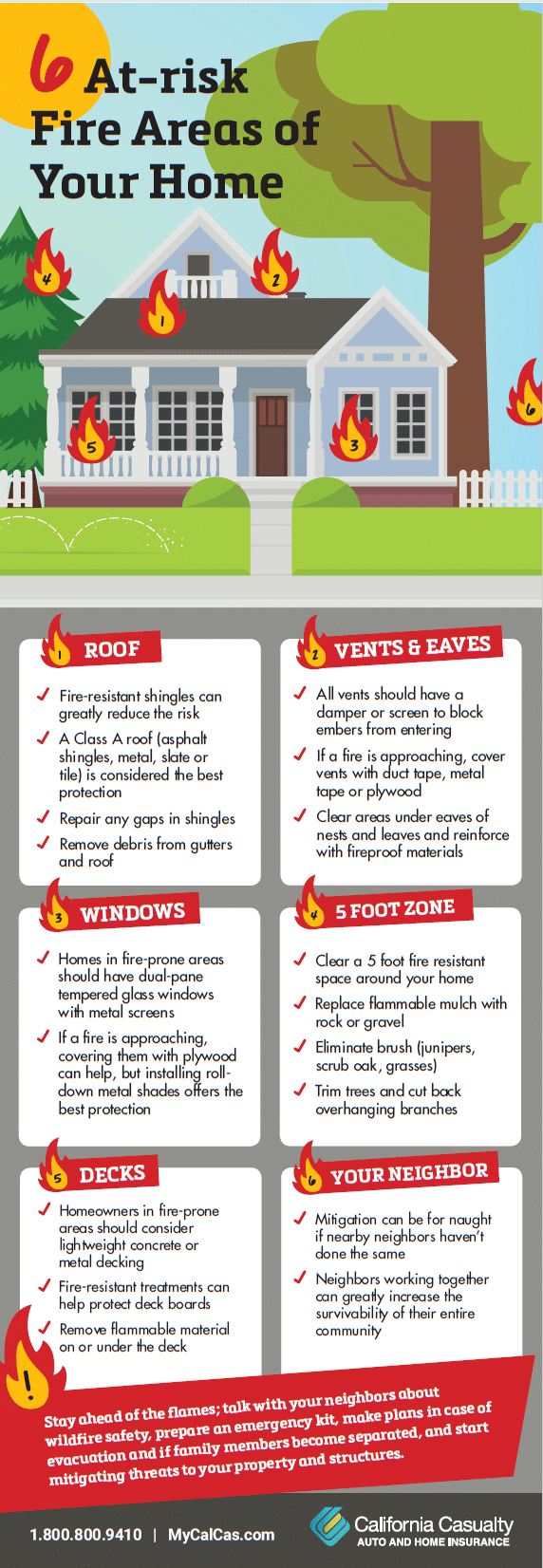
Stay ahead of the flames; talk with your neighbors about wildfire safety, prepare an emergency kit, make plans in case of evacuation and if family members become separated, and start mitigating threats to your property and structures.
Get a review of your homeowners or renters insurance policy to ensure you have adequate coverage for your property and belongings, and make a comprehensive home inventory. If the worst should happen and your home is damaged or destroyed by fire, you can find answers to your “what now?” questions here.
A California Casualty advisor is always ready to help review your policy, give you a free quote or help you start a claim at 1.866.704.8614 , or you can visit www.calcas.com.
For more information visit:
https://bit.ly/2o1IzoU
https://bit.ly/2VUNOmO
https://bit.ly/2OUPYBv
https://bit.ly/31rACHd
https://bit.ly/2MT9pI7
This article is furnished by California Casualty, providing auto and home insurance to educators, law enforcement officers, firefighters and nurses. Get a quote at 1.866.704.8614 or www.calcas.com.
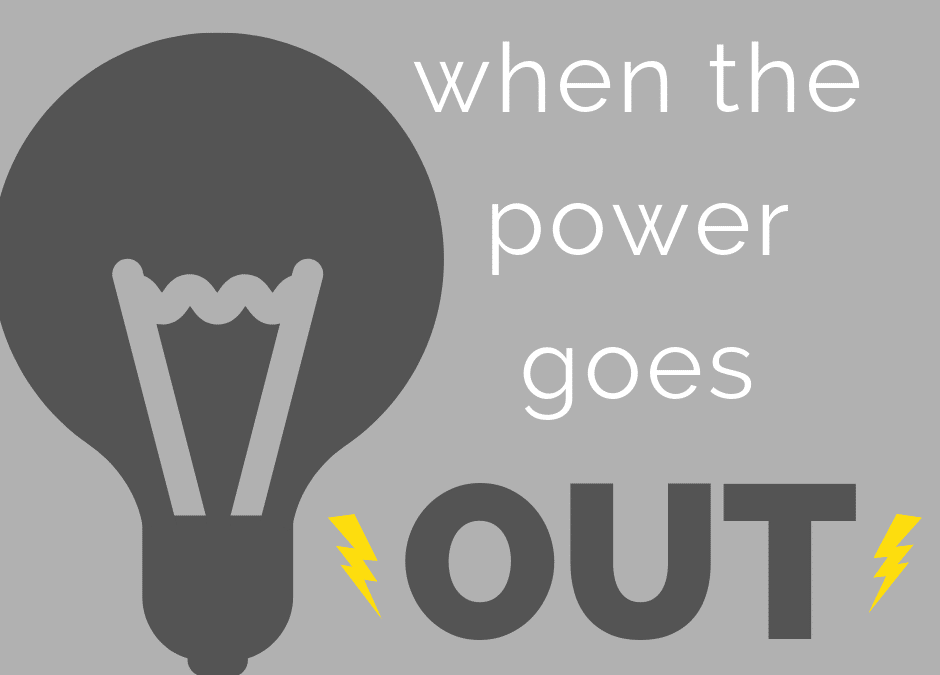
by California Casualty | News, Safety |
California utility companies are taking drastic steps to prevent wildfires by cutting power to up to one million households. Downed power lines or sparks during high winds and red flag fire warnings have been blamed for starting previous fires. The outages could last for days, depending on the fire threat. generator safety tips
Blackouts may reduce fire danger, but losing power can be frustrating and even life-threatening. Utility companies are urging customers to have an emergency supply kit and keep automobiles with a full tank of gas (in case gas stations in the area are without power). Also, you should have an emergency plan if someone depends on electricity for medical needs. It’s important to know how to manually open up garage doors and community gates if the power is out.
- Strap a headlamp facing into to a clear plastic jug filled with water to light an entire room.
- Keep a bag of stuffed animals, games and toys that don’t require electricity to occupy and entertain children.
- Turn cell phones off or to airplane mode to extend the battery life and have extra power packs or solar chargers.
- Fill your washing machine with ice to make a great cooler with a drain.
- Have a propane or briquette grill or camp stove with fuel for cooking (never use it indoors and make sure to have extra fuel or bags of briquettes).
- Store milk jugs with frozen water in your freezer to be used to keep food cold and for drinking water when the ice melts.
- Stock up on candles, or make your own from your kitchen.
- Use boxes of baby wipes if showers don’t work.
- Consider installing or buying a standby generator.
Portable generators can power heaters, water pumps and refrigerators. However, while it can light your home and make life a little more comfortable, using a portable generator can also be dangerous.
Whether you have used it once or a hundred times, it’s good to know these generator safety tips to prevent carbon monoxide poisoning and fires:
- Never use a generator inside your home or enclosed areas like a garage – fatal fumes from the engine can build up inside.
- Keep it away from open windows, vents and doors to keep dangerous fumes from entering your home.
- Install battery operated carbon monoxide detectors to warn if the exhaust is seeping into your home or shelter.
- Avoid fires: gasoline and natural gas generators create a lot of heat and can cause nearby combustibles to burn. They need to be cooled for a few minutes before adding more fuel.
- Never plug the generator directly into a home’s outlets – it can cause a dangerous “back-feed” on the power grid that can harm utility workers and others working on or repairing power lines.
- Avoid using generators that are wet or in puddles because they can cause electrocution.
- Only use heavy-duty electrical cords with portable generators that are rated for outdoor use, and make sure they are uncoiled.
It’s also a good idea to have flashlights or lanterns (with extra batteries) on-hand during a power outage. Additionally, keep an emergency kit that contains enough canned food and water to keep your family fed and hydrated for up to a week. This includes extra blankets and warm clothes, and a battery operated or crank radio to keep you up to date on emergency response and repairs.
California Casualty cares about your safety. We have numerous home safety information links available at www.calcas.com/resources.
For more information visit:
https://bit.ly/2VrmlZL
https://bit.ly/33d8CIs
https://bit.ly/2MwSkU6
This article is furnished by California Casualty, providing auto and home insurance to educators, law enforcement officers, firefighters, and nurses. Get a quote at 1.866.704.8614 or www.calcas.com.
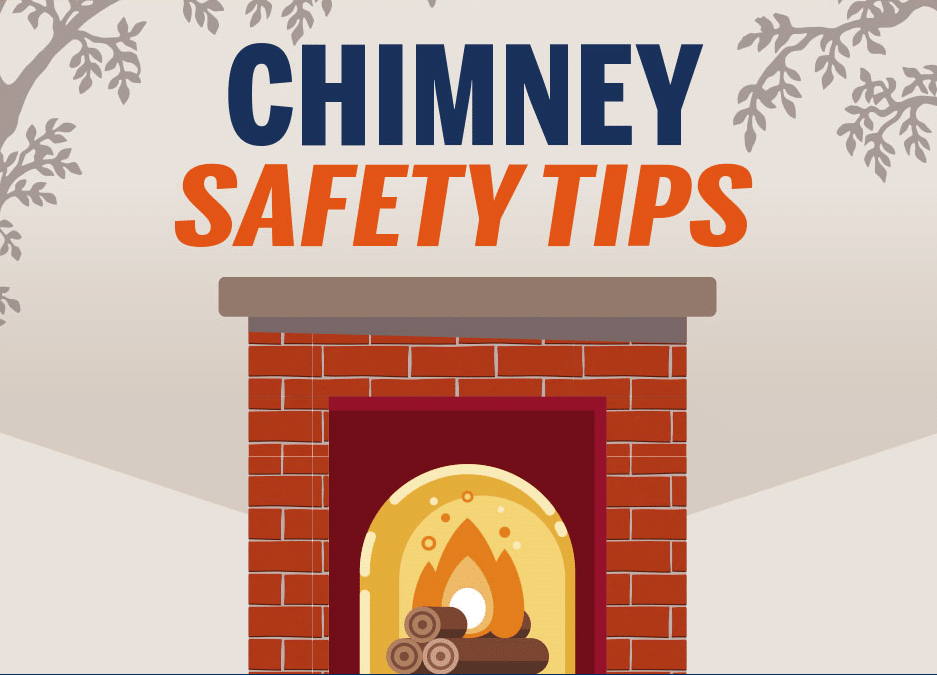
by California Casualty | Homeowners Insurance Info, Safety |
As the weather gets cooler, there is nothing cozier than curling up next to the fireplace with a cup of hot up of coffee and a good book.
Millions of people in the United States have fireplaces that they primarily use during the fall and winter to create a comfortable environment and to warm their homes. However, without the proper maintenance, a fireplace can turn from cozy to deadly in a matter of seconds.
On average over 22,000 chimney fires occur in the United States every year. That estimates to about 125 million dollars in damage to homes. Chimney fires are can be caused by stray sparks and high temperatures, however, most are caused dirty, unkept chimneys.
To prevent a chimney house-fire from happening follow these Chimney Safety Tips:
- Get your chimney cleaned yearly
- Cut and trim all overhanging branches
- Install a screencap on top of chimney
- Monitor the flue temperature
- Keep the fire screen closed
- Let ashes cool down
- Dispose of ashes far away from house
- Never burn trash or debris
- Only burn dry hardwood
- Keep firewood at least 30 ft. away
- Never leave chimney unattended
It is also important to make sure your smoke alarm and carbon monoxide alarms have batteries and are working properly. 2/3rds of fire deaths occur in homes with missing or non-functioning smoke alarms.
Install smoke and carbon monoxide alarms in every bedroom near doorways, outside each sleeping area, and on every level of your home near cooking devices and fireplaces.
Be safe this season, follow our chimney safety tips, and remember to have your chimney professionally cleaned and maintained before it’s first use to avoid a house fire.
For more safety tips click here.
This article is furnished by California Casualty, providing auto and home insurance to educators, law enforcement officers, firefighters, and nurses. Get a quote at 1.866.704.8614 or www.calcas.com.
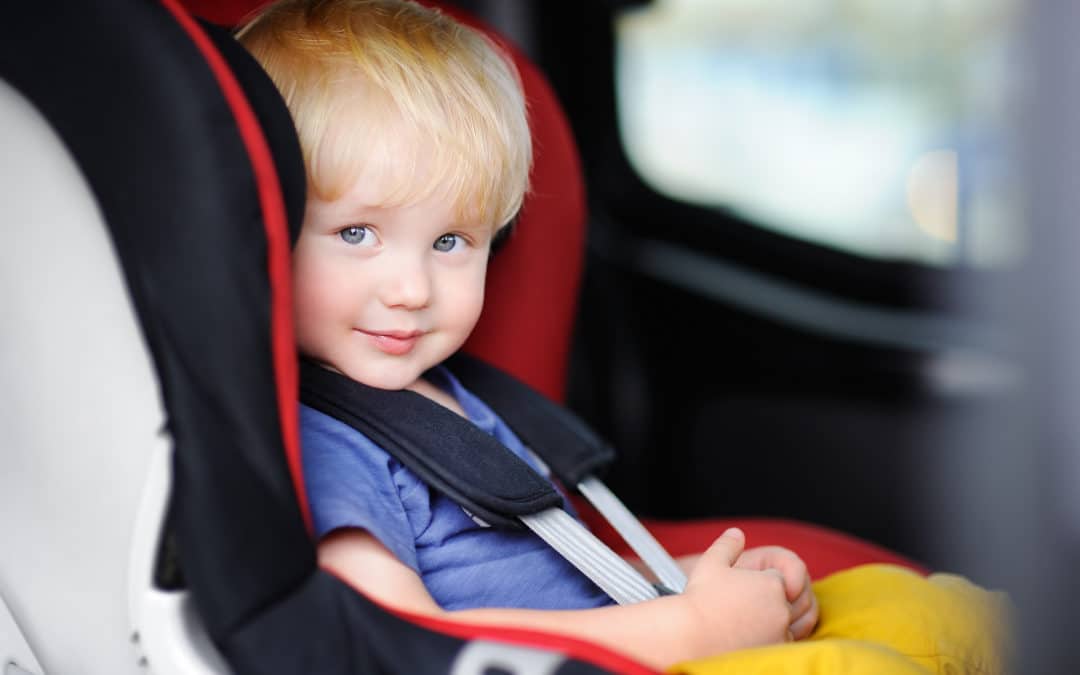
by California Casualty | Auto Insurance Info, Safety |
Protecting infants while riding in a car isn’t just a responsibility, it’s the law. Every state in the nation requires children less than three years of age to be secured in car seats, and most require booster seats and other appropriate devices even after a child outgrows their car seat.
Motor vehicle crashes are the leading cause of death for children in the United States, but having your child strapped in a car seat can save their life. Properly installed seats reduce the risk of injury in a crash 71% for infants and 54% for toddlers. There are numerous articles highlighting how properly restrained children have survived a terrible crash.
However, many parents are confused as to which type of car seat to use for what age and weight and 60% of install car seats incorrectly.
That means every day, parents, grandparents and other caregivers are accidently risking the safety of their most precious cargo.
Tips on Which Type of Car Seat to Use:
- Never buy a used car seat or booster seat, always purchase a new one.
- All car seats and boosters should only be installed in the back seat
- Infants should always ride in rear-facing car seats as long as possible
- Use a forward-facing safety seat when your child outgrows the rear-facing one, and use it until they are at least seven years old, or they get too big for a car seat
- Children should continue to ride in a booster seat until 12 years of age, or until they are big enough to fit properly into a seat belt
Tips to Install a Car Seat:
- Always do so in the back seat, using the center most position
- Make sure to use the correct seat for your child’s age and size
- Keep infants in rear facing seats
- Secure the seat so it moves no more than one inch from side to side
Anyone who is just not sure if they have the proper car seat, or if it’s installed correctly, can find a list of child passenger safety technicians and car seat safety check events in their area at the Safe Kids website.
And if you need help finding a car seat that will work best with your children, here are some resources to find the device to fit your needs:
As colder weather approaches, there’s one last important piece of advice about car safety seats. Buckle in children without heavy jackets on, to make sure they are in securely. If you worry your child will be cold, put the coat or a blanket over them after they have been fastened-in.
This article is furnished by California Casualty, providing auto and home insurance to educators, law enforcement officers, firefighters and nurses. Get a quote at 1.866.704.8614 or www.calcas.com.
For more information visit:
https://bit.ly/301qkAW
https://bit.ly/2LydguD
https://bit.ly/3001rFD
https://bit.ly/34PGxJ9
https://bit.ly/32GEXHm
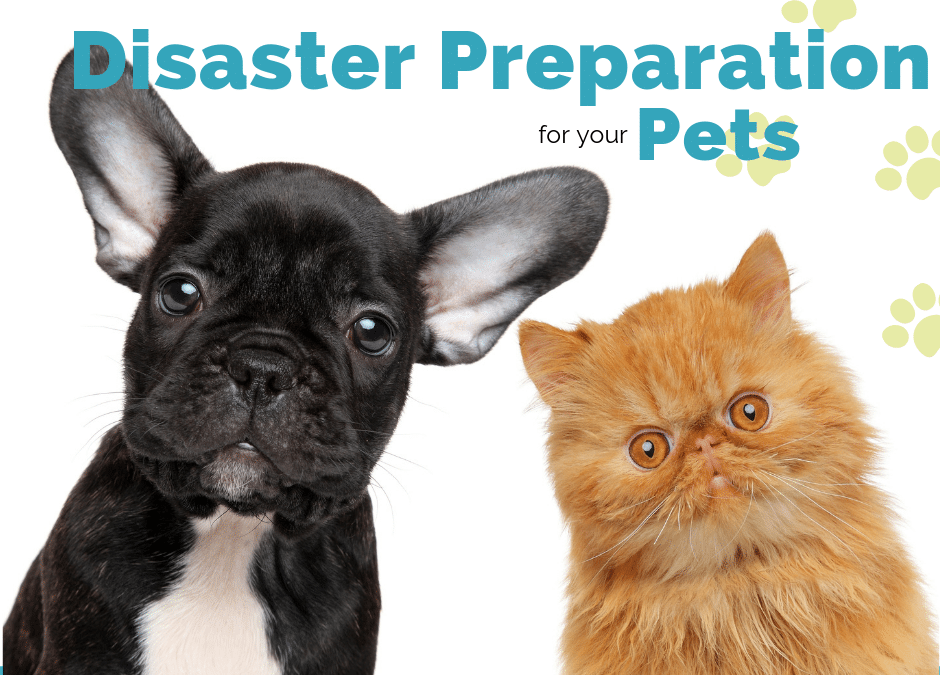
by California Casualty | Auto Insurance Info, Pets, Safety |
Our pets are precious members of the family. We take them on adventures and shower them with treats and love. However, when it comes to disaster situations, our fur babies are often an after-thought, and sadly, many suffer and are left behind when a natural disaster hits.
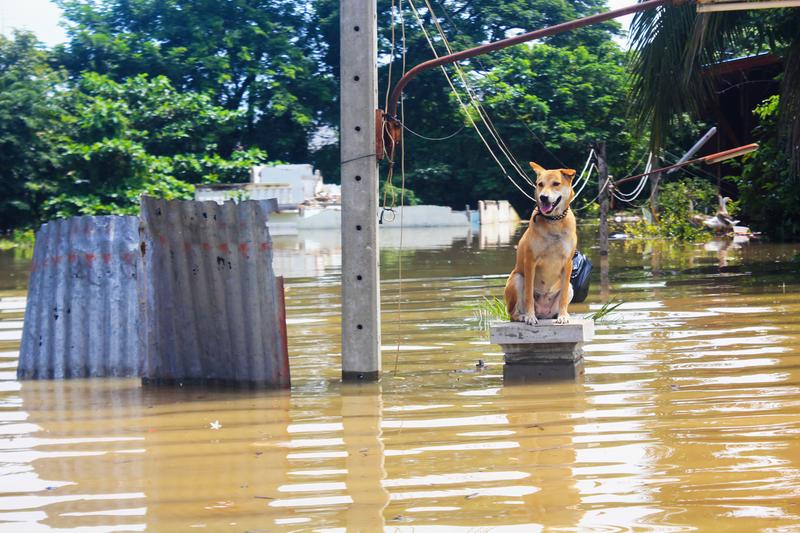
September is National Preparedness Month. Each year we are reminded to prepare ourselves for emergency disasters in our home and communities. So, while you get your emergency plans in place, don’t forget to include your animals!
Take these actions and precautions before a calamity strikes to put your mind at ease and save your pet’s life.
- Have an evacuation plan that includes your pet and it’s necessities. Include food, leash, medications, a blanket (with your scent), water, and copies of vet records and vaccinations.
- Bring your pet inside. If you need to evacuate, have a crate or duffel on hand that you can easily transport them in.
- Place a rescue alert sticker on home door or window. This should be visible to rescuers, in case you are unable to get home. Available online, at pet stores, veterinarians, or from the ASPCA.
- Microchip your pets and update collar tags. Make sure the microchip is registered and up-to-date with your current information.
- Keep in mind many evacuation shelters do not take pets. Research pet-friendly hotels, shelters, and family/friends who will take in you and your pet in a disaster.
- Carry recent pictures of your pet. In case you get separated, keep a good photo of them sitting and standing for size/coat reference.
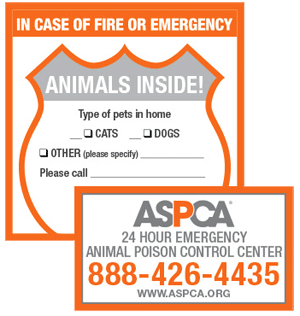
Having a disaster preparation plan in place for your pets will play a key role in saving their life in the event of an emergency. If you need help putting a plan in place, contact BringFido’s Canine Concierge. They will contact hotels and shelters across the nation to help you find somewhere for your pet. Plus, they will even give you advice on disaster preparation for pets!
Remember, pets can sense anxiety and become nervous, especially during high stress times like emergencies. It is important to give them TLC and let them know they will be ok.
This article is furnished by California Casualty, providing auto and home insurance to educators, law enforcement officers, firefighters, and nurses. In the event of a disaster know you and your pet are taken care of by adding Pet Insurance by Pets Best to your existing California Casualty policy and save up to 90% on all emergency vet bills. Get a quote at 1.866.704.8614 or www.calcas.com.
For more information visit:
https://bit.ly/34xLENY
https://bit.ly/34qK2Ft
https://bit.ly/2MTAldi






